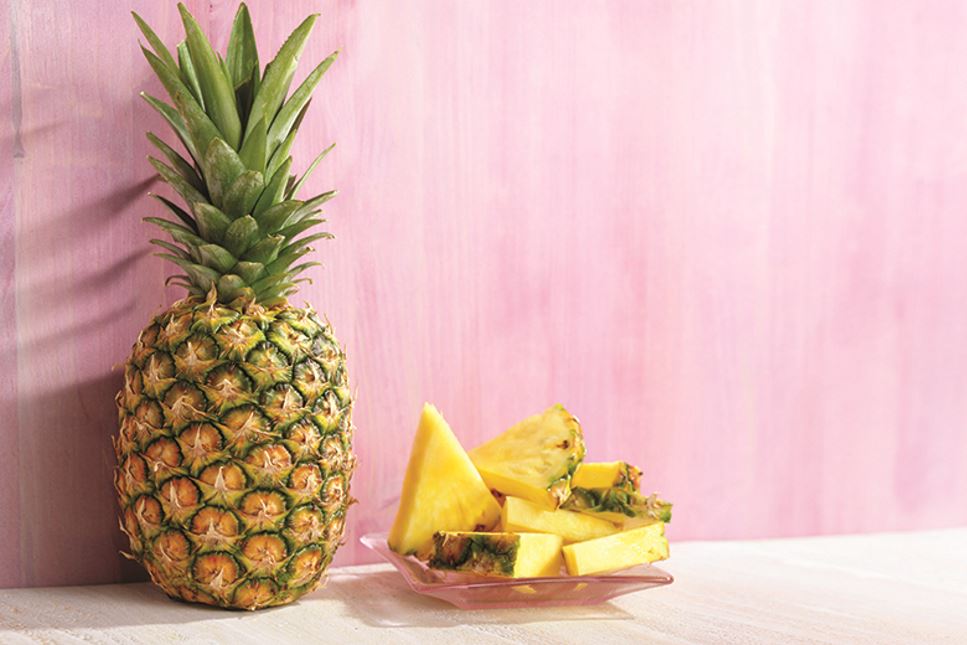A sweet and tangy fruit indigenous to the southern regions of Brazil and Paraguay, pineapple has no relation to apples or pine. Spanish settlers coined the name piña de Indies for the fruit’s pinecone resemblance. English speakers translated this to pineapple, but many languages call it ananas, meaning “excellent fruit.”
Like figs and mulberries, pineapple is not a single fruit but rather a cluster of berries fused to a core. The fruit’s flowers are visible as “scales” on the thick outer skin.
Nutritionally Speaking
Pineapple is loaded with nutrition: One cup of pineapple chunks has 82 calories, is an excellent source of vitamin C and a good source of thiamin and vitamin B6.
Interest in the health effects of bromelain, a group of enzymes in fresh pineapple, is growing. Some research has looked at the role of bromelain in reducing pain and swelling, as well as its potential to help with treating burns when applied to the skin.
Growing
Pollinators such as bees, beetles and, most notably, hummingbirds are required for the plant to reproduce. However, modern farmers have streamlined the process: By cultivating pieces of a parent plant known as propagules, a new plant will bloom. This method yields larger pineapples in less time and eliminates seeds that consumers may find undesirable.
Growing and harvesting pineapples requires patience. A plant may take three years to mature from a seed and produces only one pineapple per year.
Availability
Fresh pineapple is available year-round in the United States, with the majority imported from Costa Rica.
Purchasing
Pineapple does not ripen after being picked. The color of pineapple skin ranges from all green to all yellow; this is not necessarily a sign of ripeness, but it does indicate sweetness. A deeper yellow color indicates a higher sugar content. Choose a pineapple with fresh leaves and a plump body that slightly gives when squeezed.
You also can purchase pre-cored fresh pineapple in the refrigerated produce section of most grocery stores, or buy canned chunks, slices or crushed pineapple. Look for dried pineapple in rings or chunks, too.
Storing
Whole pineapples may be stored on countertops for up to three days. Once cut, it may be stored in the fridge for up to seven days. This recommendation applies to pre-cut pineapple you may buy, too.
Canned pineapple can be stored in the pantry for 12 to 18 months from the date of purchase. Once opened, it can be safely stored in the refrigerator for five to seven days. Frozen pineapple can be stored in the freezer for 10 to 12 months.
Preparing
Invest in a pineapple slicer or use this easy method to cut a whole pineapple: Twist off the top, use a sharp knife to cut the pineapple in quarters, core and peel the skin, then slice into cubes.
Expect about a 50% yield per pound from fresh pineapple. Once trimmed, cored and cut, a 2-pound pineapple provides about 3 cups of chunks. If canned, 8 ounces of pineapple chunks will provide ¾ cup fruit and ¼ cup juice.
Using
Versatile pineapple can be incorporated into everything from savory dishes to decadent desserts. When grilled, pineapple caramelizes, which condenses sugars and intensifies its sweetness. The enhanced flavor complexity balances saltier ingredients, such as the classic pairing with ham or mixed into salsa to serve with tortilla chips.
Bromelain in fresh pineapple, acts as a meat tenderizer — especially for tougher, less expensive cuts such as flank steak — by breaking down collagen fibers. Pair pineapple juice with teriyaki or soy sauce for a sweet and savory marinade. The meat’s thickness determines soak time, ranging from 10 to 30 minutes. Timing is important; marinating meat too long can alter its color and taste, and the texture can turn to mush. The heat process used to can pineapple destroys bromelain, so canned pineapple won’t work as a meat tenderizer.
Mix pineapple cubes with cottage cheese or add to salads just before serving. Try pineapple in fruit salad, baked goods, smoothies, stir-fry dishes and as a pizza topping. Toss dried pineapple chunks into trail mix. Although a bit of an old-fashioned dish, if you make gelatin with pineapple, you must use canned, not fresh. The bromelain in fresh pineapple breaks down the collagen in gelatin, so the mixture won’t set.
Caution
Do you have a latex allergy? An allergy to latex is a serious concern, with symptoms ranging from itchy skin to anaphylaxis. Those with a latex allergy may have a reaction after consuming certain fresh fruits (including pineapple). Known as latex-fruit syndrome, an estimated 40% to 70% of people with a known latex allergy have antibodies that cause a reaction to these foods.
This information originally appeared in Food & Nutrition Magazine®, published by the Academy of Nutrition and Dietetics.
References
Find a Nutrition Expert
Looking for credible nutrition information and recommendations? The Academy of Nutrition and Dietetics' network of credentialed food and nutrition practitioners are ready to help!

